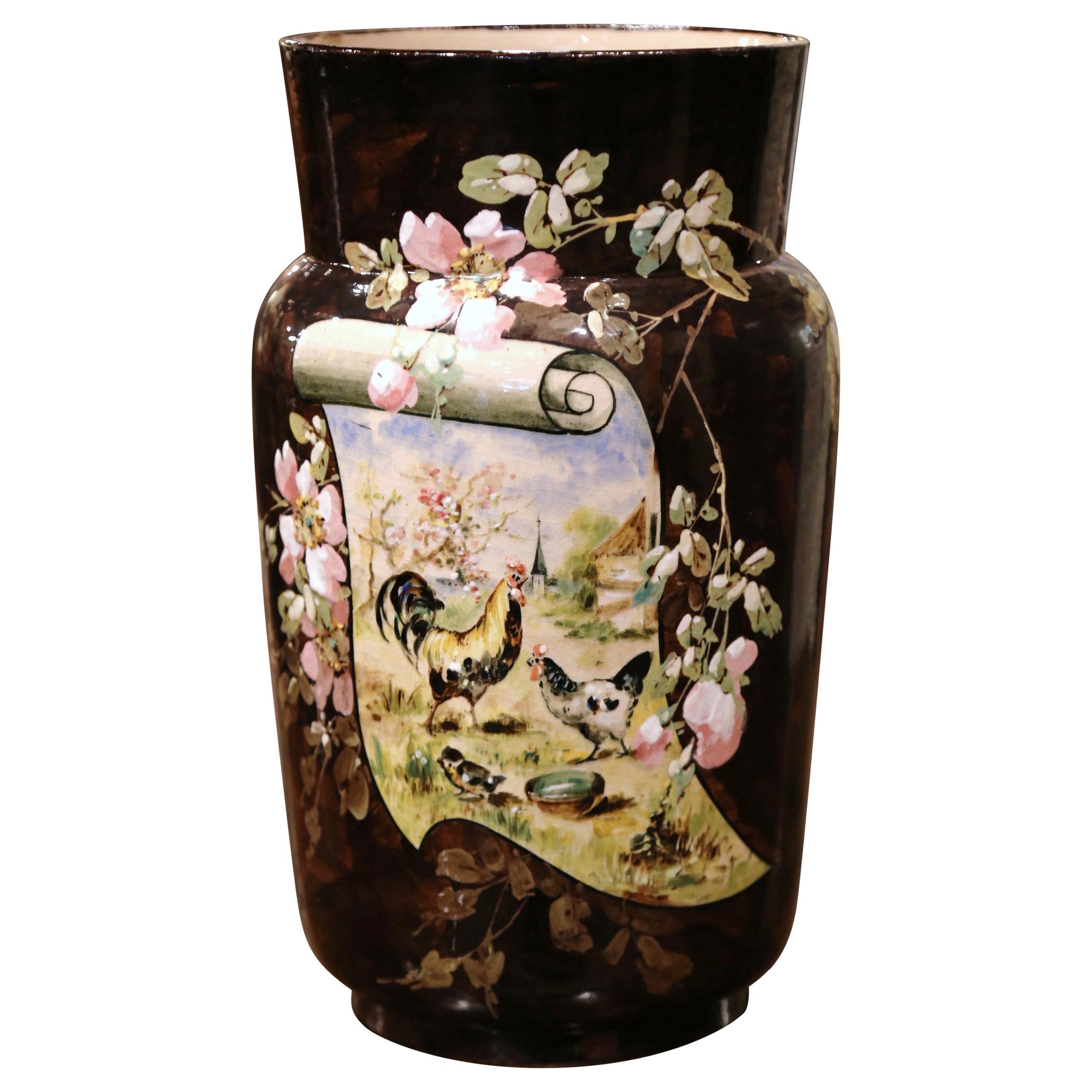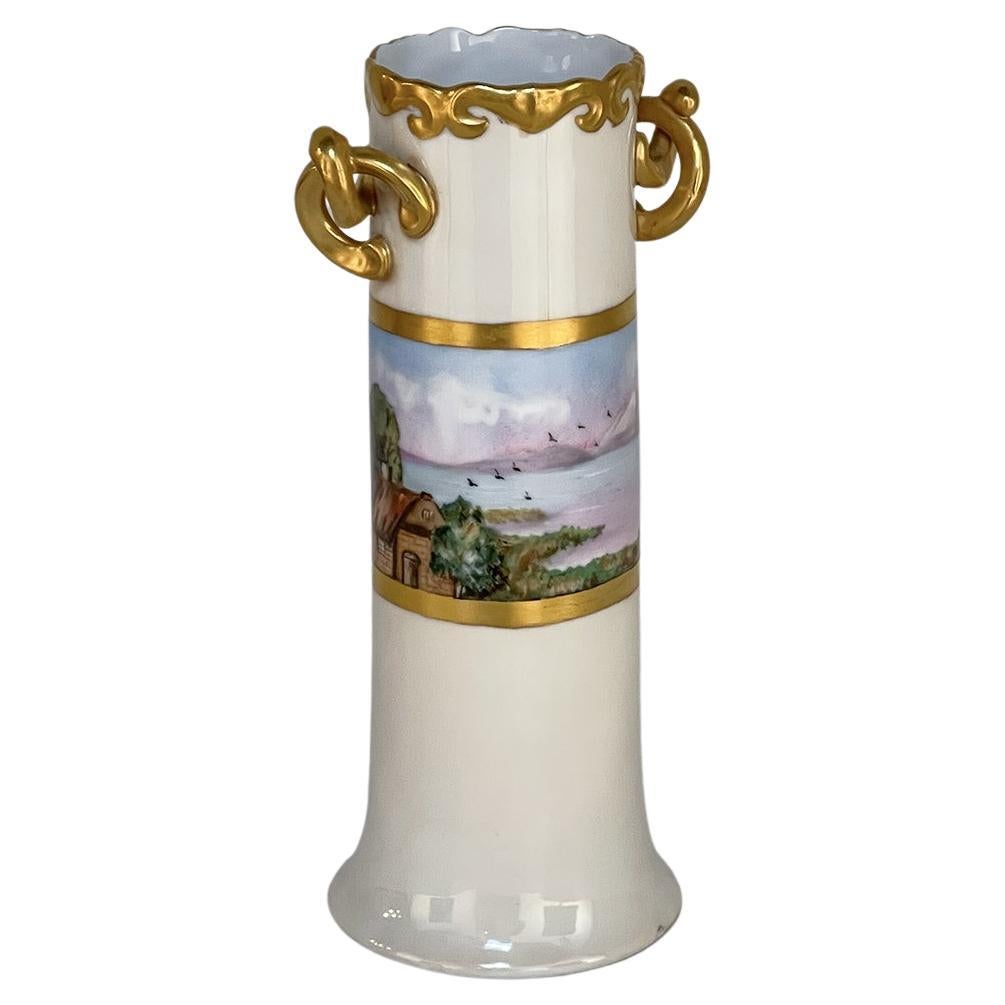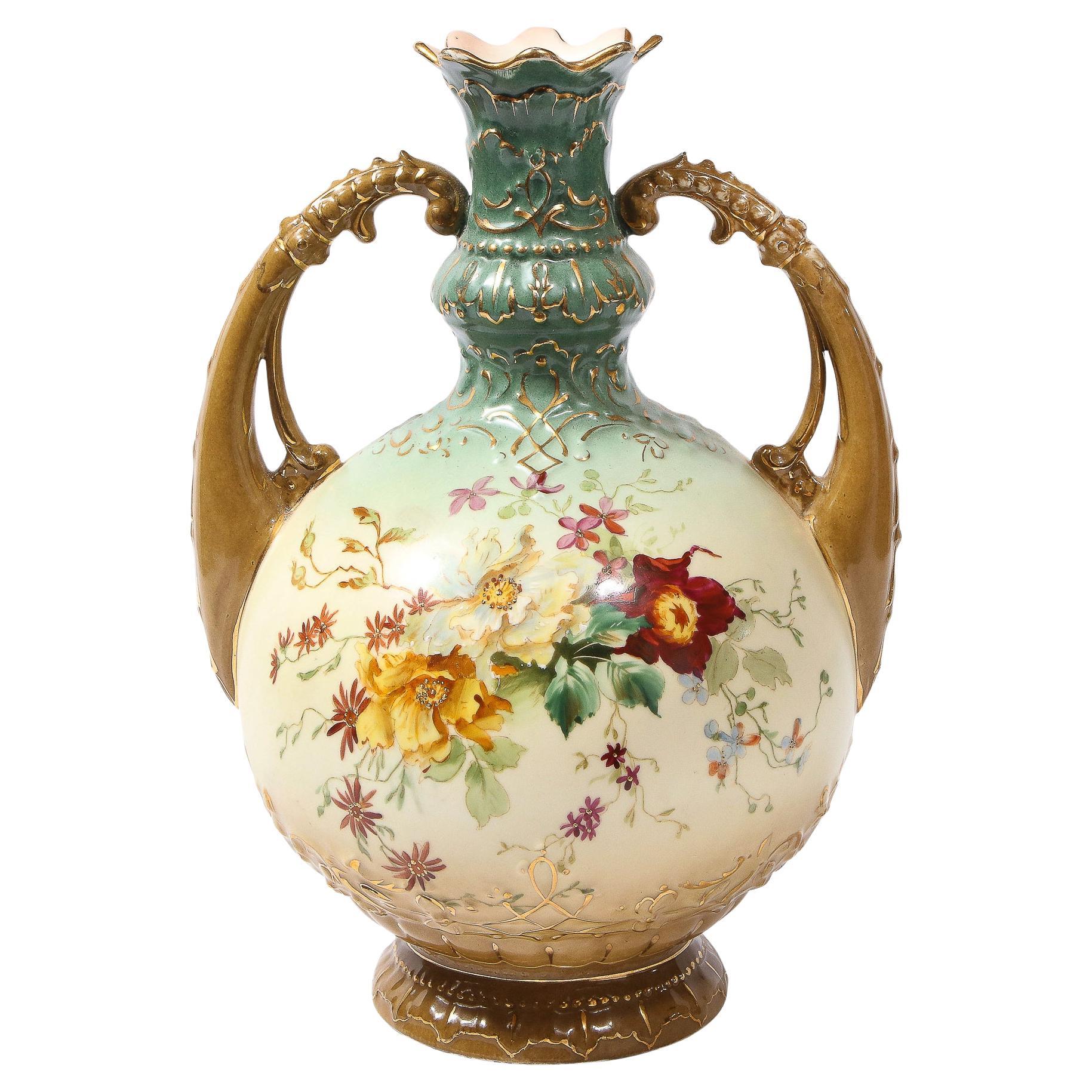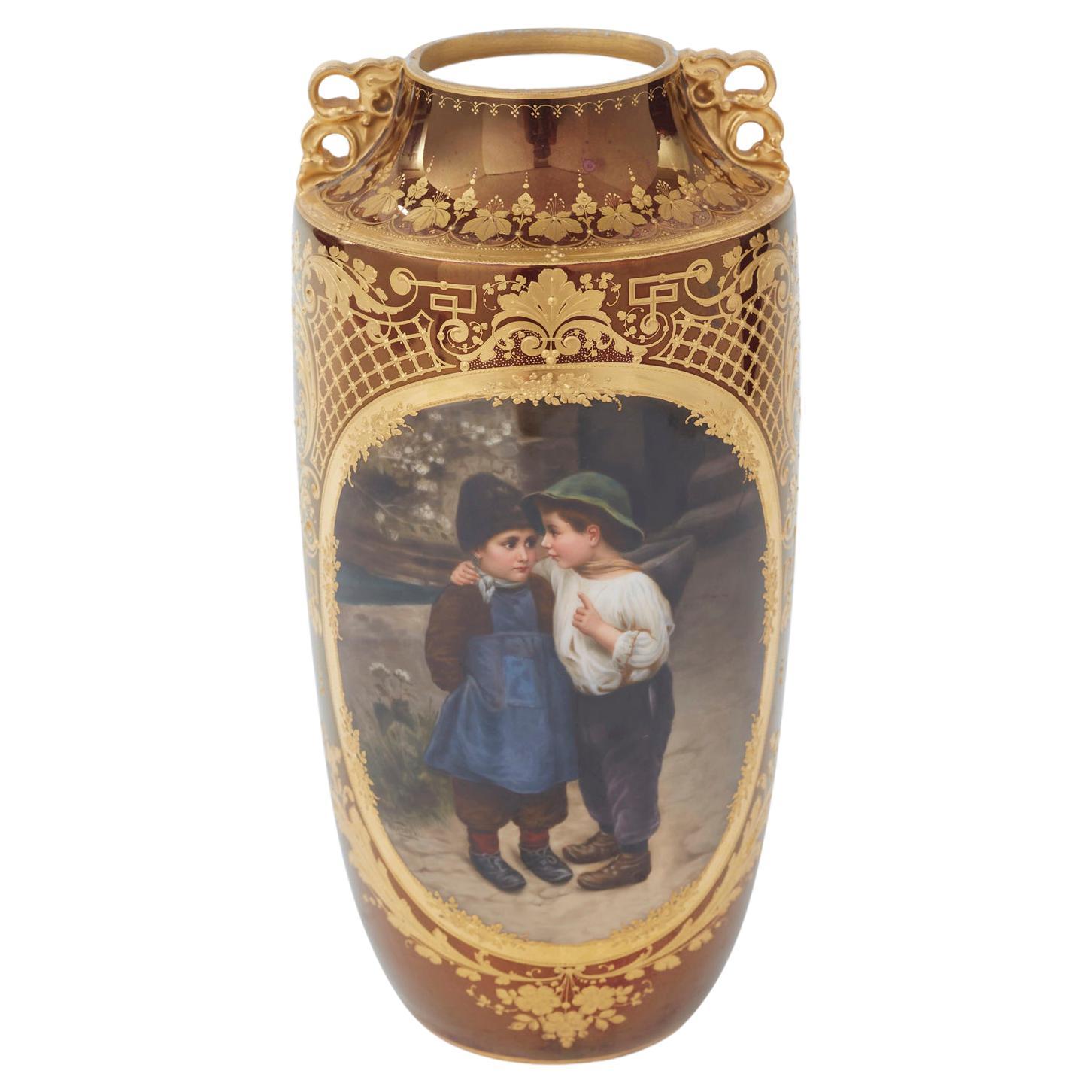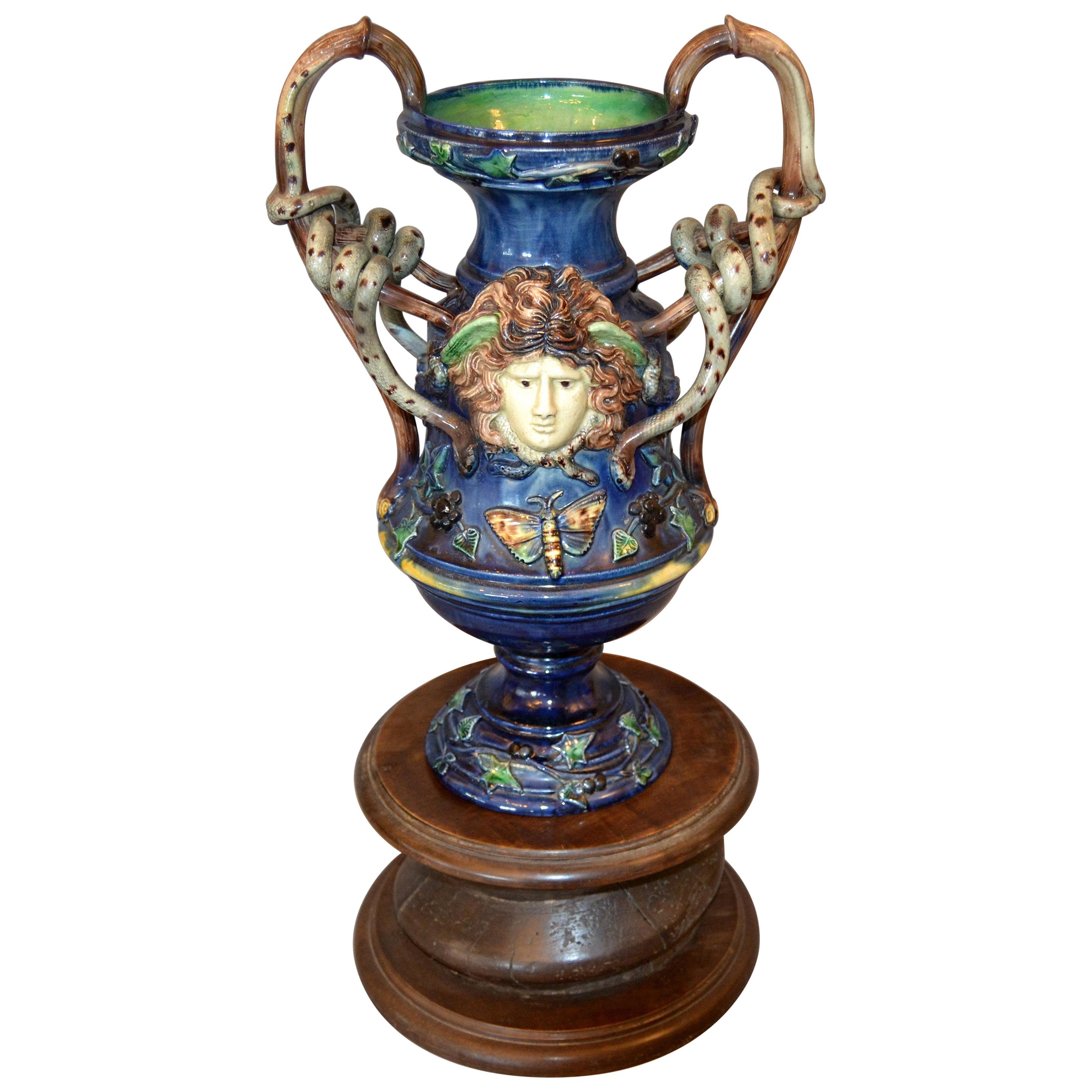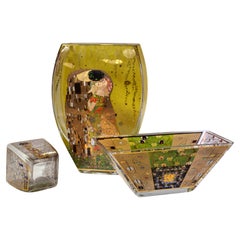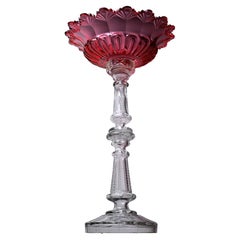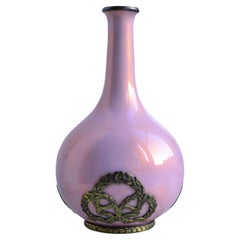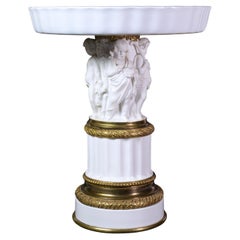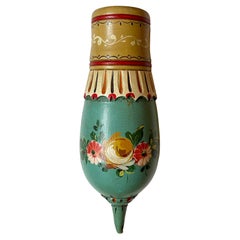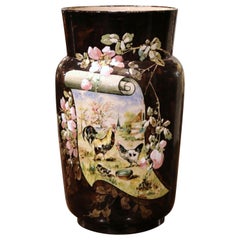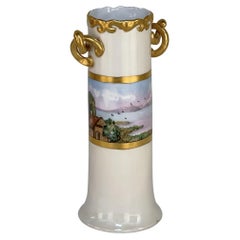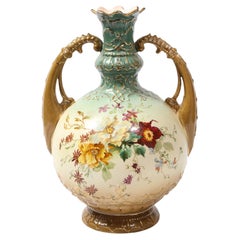Items Similar to Rare Antique Russian Abramtsevo Vase Hand Wood Carving Painting by Boehm
Want more images or videos?
Request additional images or videos from the seller
1 of 7
Rare Antique Russian Abramtsevo Vase Hand Wood Carving Painting by Boehm
$850
£644.96
€737.45
CA$1,187.22
A$1,320.03
CHF 689.25
MX$16,067.94
NOK 8,794.47
SEK 8,239.99
DKK 5,503.76
Shipping
Retrieving quote...The 1stDibs Promise:
Authenticity Guarantee,
Money-Back Guarantee,
24-Hour Cancellation
About the Item
"Boy with Sledge and Dog" is carved wooden brush pot with hand painting in oils in post - impressionist manner performed by a famous master: Elisaveta Merkuryevna Bem or Boehm or Böhm (1843–1914). Very beautiful vase that will decorate any interior. Antique wooden vases in this design and condition are a real rarity and a godsend for the collector and not only... Comes from collection.
Size app.: 18.3 cm (roughly 7.2 in) high, 7.3 cm (roughly 2.9 in) diameter. Very good condition. age usage wear. Please study good resolution images for cosmetic condition. In person actual item may appear darker or brighter than in our pictures, strictly depending on sufficient light in your environment. Weight measure some 1 kg packed for shipment.
E. Boehm russian painter, a popular designer of postcards. She was born in Saint Petersburg to a noble Russian family of Endaurov that had a Tatar origin. At the age of 14 she entered the School of Painting at the Society for Promotion of Artists there she studied under Ivan Kramskoi and Pavel Chistyakov.In 1865 she graduated from the school with the Large Silver Medal. She took private lessons from Kramskoi and studied at the Imperial Academy of Arts there she was awarded a Large Encouragement Medal for her animal paintings. She has created a recognizable style of the postcards that depicts children faces and silhouettes. According to the study of Tretyakov and Gutterman she was the most reprinted author of postcards in the Russian empire. Abramtsevo-Kudrinskaya carving is an artistic craft of wood carving, formed at the end of the 19th century in the vicinity of the Abramtsevo estate near Moscow. The emergence of the craft is closely associated with the artists of the Abramtsevo circle and, first of all, E. D. Polenova, who organized in the estate of S. I.Mamontov in 1882 a carpentry workshop, in which carvers from the neighboring villages studied and worked: Khotkovo, Akhtyrka, Kudrino, Whorls. When organizing the workshop, special attention was paid to educational activities, creating and maintaining a creative mood among students. In addition to teaching the skills of carving, drawing and the basics of painting were taught in the workshop. Classes were held in the Abramtsevo Museum: a large collection of folk-art items was collected in the estate. The workshop graduates received as a gift tools to organize their business. In 1890, one of the students, V.P. Vornoskov, founded his own production in his native village of Kudrin and began to work on the orders of the Abramtsevo workshop. This initially small workshop formed the basis of the future craft. In the Kudrino workshop, a special style of ornamental carving was formed, successful combinations of flat-relief carving with geometric carving were found, the principles of organic use of carved decor in utilitarian objects were laid. In the first years of work, professional artists - V. I. Sokolov, S. V. Malyutin, employees of the Handicraft Museum - provided great assistance in the formation of a special "Vornoskov" style. The products of Vornoskov and his followers - ladles, boxes, barrels, salt shakers, decorative dishes and vases covered with rhythmic floral ornaments - are distinguished by a variety of toning that emphasizes the natural beauty of the tree. The plant ornament is based not only on samples of carved peasant products and house decor, but also on ornamental headpieces of old printed books. The development of the ornament of the Kudrino craftsmen went from the combination of individual elements - twigs, curls, rosettes - to integral ornamental compositions covering the entire product. In 1922, the Vozrozhdenie artel was organized in Kudrin, which began to develop rapidly; in the mid-1930s, more than 120 people already worked there. The artel's products were in great demand and were repeatedly awarded with diplomas of Russian and international exhibitions. In 1936, a unique order was completed: the design of one of the entrances to the exhibition of folk art in the Tretyakov Gallery. This is the only work of Kudrintsy in the field of monumental art. For the International Exhibition in Paris in 1937, the Kudrintsy prepared an extensive collection, for which many of V.P. Vornoskov's early pieces were repeated. In subsequent years, craftsmen and artists of different generations developed the craft - V. V. Vornoskov, M.V. Artemiev, A.I. Gulyaeva, Z. N. Borodulina, T.V. Alkhimovich, L. V. Barkan, N. N. . and G. I. Simankin. Currently, the center of the craft is located in the town of Khotkovo, Sergiev Posad region, where a factory of carved art products operates. Abramtsevo-Kudrinsky carving masters are trained by the Vasnetsov Abramtsevo Art and Industry College.
- Dimensions:Height: 7.2 in (18.29 cm)Width: 2.9 in (7.37 cm)Depth: 2.9 in (7.37 cm)
- Style:Art Nouveau (Of the Period)
- Materials and Techniques:
- Place of Origin:
- Period:
- Date of Manufacture:e.g. Circa 1900
- Condition:Wear consistent with age and use. Very good condition. age usage wear. Please study good resolution images for cosmetic condition.
- Seller Location:Sweden, SE
- Reference Number:1stDibs: LU8776239700402
About the Seller
No Reviews Yet
Vetted Professional Seller
Every seller passes strict standards for authenticity and reliability
1stDibs seller since 2023
13 sales on 1stDibs
Typical response time: 4 hours
- ShippingRetrieving quote...Shipping from: Sweden, Sweden
- Return Policy
Authenticity Guarantee
In the unlikely event there’s an issue with an item’s authenticity, contact us within 1 year for a full refund. DetailsMoney-Back Guarantee
If your item is not as described, is damaged in transit, or does not arrive, contact us within 7 days for a full refund. Details24-Hour Cancellation
You have a 24-hour grace period in which to reconsider your purchase, with no questions asked.Vetted Professional Sellers
Our world-class sellers must adhere to strict standards for service and quality, maintaining the integrity of our listings.Price-Match Guarantee
If you find that a seller listed the same item for a lower price elsewhere, we’ll match it.Trusted Global Delivery
Our best-in-class carrier network provides specialized shipping options worldwide, including custom delivery.More From This Seller
View AllGustav Klimt in Goebel Artis Orbis Vintage 3 pcs Glass Ensemble Vase Bowl Set
By Goebel Company
Located in Sweden, SE
Gustav Klimt, the renowned Austrian painter and a prominent figure in the Viennese Art Nouveau movement, has left an indelible mark on the world of art. His influence has transcended...
Category
Late 20th Century Art Deco Vases
Materials
Gold Plate
Antique Сrystal Tazza Two Tone 19th century Russian Imperial Factory Fruit Vase
By Imperial Russia
Located in Sweden, SE
Antique and absolutely exclusive, fully hand crafted at Russian Imperial Glass Factory in first half of 19th century. Beautiful combination of colors and unique shape and architectur...
Category
Antique 1830s Russian Empire Vases
Materials
Crystal
Gilt Silver Pink Enamel Miniature Vase early 20th century Finnish Master
By August Hollming 1
Located in Sweden, SE
Hallmarks: 'A*H' , mark '88' and image of a female head in a kokoshnik, leads to the time of Imperial Russia and Finish silversmith August Frederik Hollming (1854 – 1913), who worked at Faberge. Unusual and incredibly beautiful empire style miniature vase. The elegant jewelry work and design of the vase vaguely resembles a beautiful pearl drop. The color palette and tone of the vase changes surprisingly depending on the lighting. By level of jewelry craftsmanship and fantasi with which this vase is made, we assume that the vase was made by a very high class Finnish jeweler by A. F. Hollming, comparable to famous Russian jewelers such as Carl Fabergé. The design of his jewelry was surprisingly modern and ahead of its time. Full handmade: hand-drawn, embossing, hand chased, engraved and casting of finest quality. Besides the bottom there are few hallmarks on applied garlands. Comes from Swedish estate.
Size app.: 13 x 9 cm (roughly 5.11 x 3.54 in). Weight app. is 195 gram (app. 0.42 lb). Very good condition, minimal wear. Silver, enamel, gilding. Please study good resolution images for cosmetic condition. In person actual colors may appear darker or brighter than in our pictures, strictly depending on sufficient light in your environment. Volume weight measures some 1 kg packed for shipment.
August Frederik Hollming was born in Loppi, Finland. Hollming was apprenticed to the goldsmith Carl Friedrich Ekholm in Helsinki at the beginning of the 1870s. In 1876, he settled in St. Petersburg and registered as a goldworker. In 1880, he qualified as a master and opened his workshop at 35 Kazanskaya Street, St. Petersburg, he was soon thereafter hired by Fabergé. In 1900, the Hollming workshop moved to 24 Bolshaya Morskaya, St. Petersburg, under the same roof as Fabergé. The eldest son August Väinö Hollming...
Category
Early 20th Century Finnish Empire Sterling Silver
Materials
Gold Plate, Silver, Enamel
Bisque Porcelain and Gilt Bronze Vase 19th century 4 Seasons Putti Allegory
Located in Sweden, SE
Empire Vase (Tazza) produced in bisque porcelain by top level manufacture, possibly in Germany or France, in the second half of the 19th century and decorated with finely crafted fin...
Category
Antique Late 19th Century Empire Vases
Materials
Gold, Bronze
Russian Tempera Icon of the Protection 19th century Intercession of Theotokos
Located in Sweden, SE
Icon "The Intercession of the Theotokos, or the Protection of Our Most Holy Lady Theotokos and Ever - Virgin Mary", is a Christian feast of the Mother of God celebrated in the Easter...
Category
Antique Late 19th Century Russian Neoclassical Religious Items
Materials
Wood
Antique Russian Cut Crystal Glass Vase with Floral Engraved 19th century
Located in Sweden, SE
Gorgeous vase of lightly gray crystal glass, made with masterful skill by master glassblowers of past centuries, decorated with 3 round medallions of various garden flowers. Signed a...
Category
Antique Late 19th Century Russian Baroque Vases
Materials
Crystal
You May Also Like
Vintage Bavarian KUMPF Wooden Wall Vase, Traditional Folk Art 1970s, Germany
Located in Andernach, DE
Beautifully hand decorated 'Kumpf', which origins date back to the 1st to 2nd century a.d., Germany or Tyrol, Austria.
The farmers or craftsmen would store their sharpening stone in ...
Category
Antique 19th Century German Biedermeier Vases
Materials
Wood
$159 Sale Price
51% Off
19th Century French Hand Painted Ceramic Barbotine Vase Stamped T. LeFront
By Théodore Lefront 1
Located in Dallas, TX
This large hand painted antique vase was created in France circa 1865, made of Majolica, the colorful vase depicts a hand painted scene with ...
Category
Antique Mid-19th Century French Vases
Materials
Majolica, Ceramic, Porcelain
Antique Hand-Painted Vase from Bavaria
Located in Dallas, TX
Antique hand-painted vase from Bavaria is a wonderful example of the fine porcelains produced by the southern region of today's Germany. The elaborately formed handles contrast with ...
Category
Early 20th Century German Baroque Revival Vases
Materials
Porcelain
Austrian Antique Art Nouveau Hand Painted Handled Vase by EW
Located in New York, NY
This stunning and graphic Art Nouveau vase was realized in Austria circa 1910. It features a circular base with a gourd form body that ascends into a slender undulating neck and a sc...
Category
Vintage 1910s Austrian Art Nouveau Vases
Materials
Porcelain, Paint
Royal Vienna Porcelain Decorative Vase / Piece
Located in Tarry Town, NY
Royal Vienna gilt gold porcelain decorative vase / piece with exterior design details. The vase / piece was painted by Wagner Finely, ackermann & Frit Gesetzlich Geschutzt...
Category
Antique Late 19th Century European Vases
Materials
Gold
French 19th Century Antique Hand Painted Ceramic Vase Wine Decanter Wooden Riser
Located in Miami, FL
This neoclassical wine themed antique glazed and hand painted ceramic wine jar, vase, decanter was made in France, circa 1890.
The brown handles are shaped like old vines and snakes are surrounding them.
It is decorated with colorful...
Category
Antique Late 19th Century French Neoclassical Vases
Materials
Ceramic
More Ways To Browse
Russian Carved
Relief Carving Wood
Antique Russian Objects
Hand Painted Large Pots
Antique Painting Tools
Antique Carving Tools
Small Antique Barrel
19th Century Lacquer Vases
Russian Ornaments
Antique Drawing Tools
Arts And Crafts Hall Tree
Art Nouveau Wood Carving
Antique Wooden Rosettes
19th Century Shaker Furniture
Art Nouveau Hall Tree
Antique Wooden Barrels
Antique Salt Shakers
Large 19th Century Dog Painting

